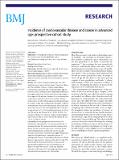| dc.contributor.author | Driver, Jane A. | |
| dc.contributor.author | Djoussé, Luc | |
| dc.contributor.author | Logroscino, Giancarlo | |
| dc.contributor.author | Gaziano, John Michael | |
| dc.contributor.author | Kurth, Tobias | |
| dc.date.accessioned | 2012-01-08T23:55:16Z | |
| dc.date.issued | 2008 | |
| dc.identifier.citation | Driver, Jane A, Luc Djoussé, Giancarlo Logroscino, J Michael Gaziano, and Tobias Kurth. 2008. Incidence of cardiovascular disease and cancer in advanced age: prospective cohort study. BMJ: British Medical Journal 337. | en_US |
| dc.identifier.issn | 0959-8138 | en_US |
| dc.identifier.uri | http://nrs.harvard.edu/urn-3:HUL.InstRepos:7349722 | |
| dc.description.abstract | Objective: To investigate the influence of increasing age on the incidence and remaining lifetime risk of cardiovascular disease and cancer in a cohort of older men. Design: Prospective cohort study. Setting: United States. Participants: 22 048 male doctors aged 40-84 who were free of major disease in 1982. Main outcome measures: Incidence and remaining lifetime risk of major cardiovascular disease (myocardial infarction, stroke, and death from cardiovascular disease) and cancer. Results: 3252 major cardiovascular events and 5400 incident cancers were confirmed over 23 years of follow-up. The incidence of major cardiovascular disease continued to increase to age 100. Beginning at age 80, however, major cardiovascular disease was more likely to be diagnosed at death. The incidence of cancer peaked in those aged 80-89 and then declined. Cancers detected by screening accounted for most of the decline, whereas most cancers for which there was no screening continued to increase to age 100. Unadjusted cumulative incidence overestimated the risk of cardiovascular disease by 16% and cancer by 8.5%. The remaining lifetime risk of cancer at age 40 was 45.1% (95% confidence interval 43.8% to 46.3%) and at age 90 was 9.6% (7.2% to 11.9%). The remaining lifetime risk of major cardiovascular disease at age 40 was 34.8% (33.1% to 36.5%) and at age 90 was 16.7% (12.9% to 20.6%). Conclusions: In this prospective cohort of men, the incidence of new cardiovascular disease continued to increase after age 80 but was most often diagnosed at death. The decrease in incidence of cancer late in life seemed largely due to a decline in cancers usually detected by screening. These findings suggest that people aged 80 and older have a substantial amount of undiagnosed disease. The remaining lifetime risk of both diseases approached a plateau in the 10th decade. This may be due to decreased detection of disease and reporting of symptoms and increased resistance to disease in those who survive to old age. Accurate estimates of disease risk in an aging population require adjustment for competing risks of mortality. | en_US |
| dc.language.iso | en_US | en_US |
| dc.publisher | BMJ Publishing Group Ltd. | en_US |
| dc.relation.isversionof | doi://10.1136/bmj.a2467 | en_US |
| dc.relation.hasversion | http://www.ncbi.nlm.nih.gov/pmc/articles/PMC2600919/pdf/ | en_US |
| dash.license | LAA | |
| dc.title | Incidence of Cardiovascular Disease and Cancer in Advanced Age: Prospective Cohort Study | en_US |
| dc.type | Journal Article | en_US |
| dc.description.version | Version of Record | en_US |
| dc.relation.journal | BMJ: British Medical Journal | en_US |
| dash.depositing.author | Driver, Jane A. | |
| dc.date.available | 2012-01-08T23:55:16Z | |
| dash.affiliation.other | HMS^Medicine-Brigham and Women's Hospital | en_US |
| dash.affiliation.other | HMS^Medicine-Brigham and Women's Hospital | en_US |
| dash.affiliation.other | SPH^Epidemiology | en_US |
| dash.affiliation.other | HMS^Medicine-Brigham and Women's Hospital | en_US |
| dc.identifier.doi | 10.1136/bmj.a2467 | * |
| dash.contributor.affiliated | Driver, Jane | |
| dash.contributor.affiliated | Kurth, Tobias | |
| dash.contributor.affiliated | Gaziano, John | |


